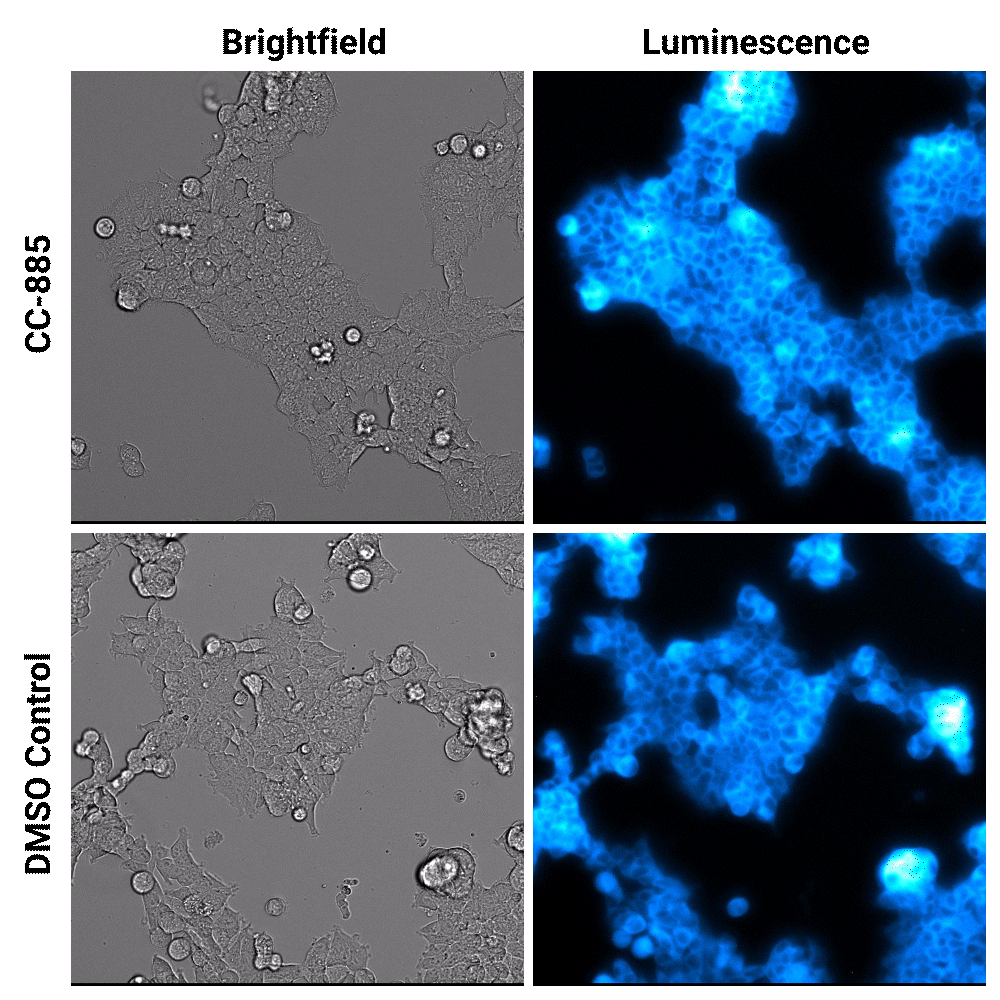Live Cell Imaging
Learn about live cell imaging techniques, advantages and applications.
What is Live Cell Imaging?
Live cell imaging is a technique used in life science research to observe living cells in real-time over a period of time. This allows researchers to observe dynamic cellular processes, such as cell division, migration, and differentiation. This is in contrast with conventional fixed-cell imaging, which only captures a snapshot in time. Live cell imaging is especially useful for examining progress in tissues that change over time, such as cancerous tissues.
Advantages of Live Cell Imaging
- Real-time observation: Study events as they occur in cells over time, without having to take ‘snapshots’ of time.
- Non-invasive monitoring: Typical live cell imaging allows observation without significant harm to cells.
- Easily multiplex: The use of different fluorescent and bioluminescent markers enable the observation of several targets simultaneously within the same sample.
Disadvantages of Live Cell Imaging
- Risk of photobleaching and phototoxicity: Long exposure times may result in changes in signal.
- Markers can interfere with normal cellular function: The presence of foreign molecules or larger tags may alter cellular processes over long periods of time.
- Depth penetration: With fluorescent microscopy, signals generated deep within tissues may be difficult to discern.
Fluorescent vs Bioluminescent Live Cell Imaging
Fluorescent and bioluminescent reporters are essential tools in live cell imaging, as they generate the light signal that enables imaging in real time. Fluorescent reporters, such as fluorescent proteins and dyes, allow for the precise localization and monitoring of specific molecules within cells. Bioluminescent reporters, which generate light through enzymatic reactions within the cell, are particularly useful for imaging over extended periods with minimal phototoxicity and background interference. Learn more about their advantages and disadvantages below:
| Fluorescent Reporters | Bioluminescent Reporters | |
|---|---|---|
| Advantages |
|
|
| Disadvantages |
|
|
Live Cell Imaging System
Live cell imaging systems are specialized instruments that include a microscope, environmental control and image acquisition software. This combination allows cells to maintain viability while being imaged over a long period of time.
The GloMax® Galaxy Bioluminescence Imager combines the strength of bioluminescent and fluorescent reporters with live imaging capabilities. It is designed to enable imaging of our NanoLuc® Luciferase technologies (e.g., NanoBRET, NanoBiT, HiBiT and Lumit) to visualize various cellular processes:
- Protein:protein interactions
- Protein localization and translocation
- Protein degradation and stability
- Ligand:protein interactions (target engagement)
- Targeted cell killing


Webinar: Real Time Live Cell Imaging and Analysis for Drug Discovery
Time- and dose-dependent analysis of cellular responses to drug treatments is critical in the drug discovery and characterization process. Join our webinar in which we present data on evaluating multiple small molecular inducers of apoptosis, and the physiological and morphological changes that occur in real-time. Learn how to connect kinetic detection with live cell imaging capabilities.
Bioluminescent Live Cell Imaging
Bioluminescent live cell imaging allows direct visualization of protein dynamics in living cells without the need for repeated sample excitation.
How does bioluminescence work?
NanoLuc® Luciferase reporters are well-suited for use in bioluminescent imaging studies. The extreme brightness means that exposure times can be reduced to only a few seconds, compared to the minutes required for other luminescent reporter proteins. Its small size also makes it less likely to perturb the normal biology or functionality of the fusion partner. Our Nano-Glo® Extended Live Cell Substrates have increased signal stability, allowing extended kinetic analysis lasting several hours to days.


Dr. Li-Fang Chu's lab observed the exact timing of oscillating genes in early human development for the first time using bioluminescent live cell imaging. Read more in this blog
Fluorescent Live Cell Imaging
Fluorescent Ligands for Live Cell Imaging
We offer a large variety of fluorescent HaloTag® Ligands that enable live cell imaging. Explore our full suite of fluorescent ligands.
Fluorescent Live Cell Imaging Protocol
Interested in fluorescent live cell imaging, but not sure where to start? We provide comprehensive protocols for both rapid and no-wash live-cell imaging using our fluorescent HaloTag® Ligands. View the protocol to learn how to optimize a signal that is both robust and specific.

Webinar: Using HaloTag® Technology and Janelia Fluor® Dyes for Live Cell Single-Molecule Imaging
Live cell single-molecule imaging is a powerful approach to analyze the sub-cellular dynamics and biochemical properties of biomolecules in their endogenous context. Learn about the scientific questions single-molecule imaging can address, the equipment required to carry out the experiments, and best practices for using the HaloTag® and Janelia Fluor® dyes to generate the best data.
Live Cell Imaging Applications
Cancer Research
Live cell imaging allows for the tracking of tumor cell behavior, including growth, invasion, and response to treatments. Cancer-specific markers and pathways can be monitored in real time using live cells.
Neuroscience
Live cell imaging enables the observation of neuronal activity, such as synaptic function and calcium signaling, within live neurons and larger neuronal networks. This technique allows for the study of neuron-specific genes and pathways that are implicated in neurodegenerative conditions over extended periods.
Developmental Biology
Developmental processes like cellular proliferation, replication, and tissue formation are well-suited for study through live cell imaging. Understanding these processes requires visualizing the spatial and temporal patterns of gene expression and protein localization.
Microbiology
Microbial cells can be labeled with fluorescent or bioluminescent markers, enabling the study of host-pathogen interactions, biofilm formation, and microbial behavior. This approach is particularly useful for observing bacterial and viral infections, which is crucial for developing effective antimicrobial treatments.
Immunology
Live cell imaging allows for the visualization of immune processes, including immune cell interactions, signaling pathways, and the immune response to pathogens. It can closely monitor inflammatory responses, such as gene activation in response to infection, and processes like phagocytosis.
Additional Resources
Imaging
Learn about various imaging techniques, including live cell imaging, in vivo imaging, bioluminescence imaging and fluorescence microscopy.
In Vivo Imaging
Learn about in vivo imaging techniques including bioluminescence and fluorescence imaging, advantages, challenges, and applications in research.
Bioluminescence Imaging
Learn about bioluminescence imaging in whole animals and in live cells.